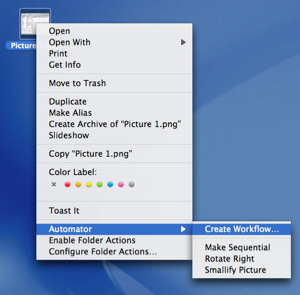
I was reading on Pronet Advertising that URL’s Matter. Basically the article states that because Pronet Advertising had three different URLs to the same thing listed in del.icio.us they didn’t hit the top of the ‘popular list’. If all the del.icio.us bookmarks had used the same URL, Pronet Advertising would have been much more successful.
The article does a good job describing the problem. More than 3,000 people bookmarked the site but three distinct addresses were used. The article suggests using redirection to make sure that all users see the same page. So for example, if the visitor comes in on http://playingwithwire.com, he or she should be redirected to http://www.playingwithwire.com.
This is sensible but it isn’t enough. Imagine if you have a blog like we do. The article you are reading right now actually appears in three different places, each with a differnt URL! For a while it will be on our front page. It will also be in our archive page for this month. And finally it has its own post page.
 Ultimately you want everyone to bookmark your posting page because that’s where the article ‘really’ lives. Enter Cuzimatter. By using our clever social bookmarking utility you can ensure that most users bookmark exactly the same page URL, regardless of if they read it from your front page, your archive, your post page, your alternative URL, someone else’s mirror – anything. The Cuzimatter links happily follow your blog post around and make sure bookmark happy users end up bookmarking your page.
Ultimately you want everyone to bookmark your posting page because that’s where the article ‘really’ lives. Enter Cuzimatter. By using our clever social bookmarking utility you can ensure that most users bookmark exactly the same page URL, regardless of if they read it from your front page, your archive, your post page, your alternative URL, someone else’s mirror – anything. The Cuzimatter links happily follow your blog post around and make sure bookmark happy users end up bookmarking your page.
If you want a live demonstration just bookmark this page using our Cuzimatter links below. You know you want to. :)
Author: Alexander Ljungberg Tags: guide,
internet,
PR

I was reading Lifehacker’s blog about resizr this morning. Turns out that if you have a Mac, there is a much easier and faster way. No need for big bloated software, just the Automator and Preview. This is how you do it:
- Put your image on your Desktop. Or wherever you can find it. In our example here, the picture is called ‘Picture 1.png’.
- Right click the image. Go to ‘Automator’ and select ‘Create Workflow…’. (In the screenshot I have some previously created Workflows you might not have. That’s okay.)

 This will bring up the Automator screen. Sweet. On the right hand side in the Automator you will see your picture preselected in an ‘Action’ called ‘Get Specified Finder Items.’ This tells Automator to load the picture you right clicked on in the second step.
This will bring up the Automator screen. Sweet. On the right hand side in the Automator you will see your picture preselected in an ‘Action’ called ‘Get Specified Finder Items.’ This tells Automator to load the picture you right clicked on in the second step.- Now go into the Library on the left side and select ‘Preview’ as your Application. Preview has an action called ‘Scale Images’. Just what we need! So double click that action to add it. Automator will ask you if you want to add an action to make a copy of the picture before resizing it, so that you can keep your original. If you want to do this, click ‘Add’, but make sure you are not trying to copy the image from the Desktop to the Desktop. For some reason this doesn’t work.
 You will find the ‘Scale Images’ Action in your list of actions now. Go ahead and set the desired size you want. I’m setting it to 480 pixels, meaning the image will be 480 pixels wide once the Automation has run.
You will find the ‘Scale Images’ Action in your list of actions now. Go ahead and set the desired size you want. I’m setting it to 480 pixels, meaning the image will be 480 pixels wide once the Automation has run.- Click the big ‘Run’ button and you’re done! Preview will automatically load your picture, optionally make a copy of it, and then scale it to the size you wanted.
Not bad for a couple of clicks, huh? Now the cool thing with the Automator is that you can save this Automation. Then you can access it by just right clicking an image and selecting your image scaling action from the Automator drop down. Before you save your Automation, make sure to change the first action in the list to ‘Get Selected Finder Items’. Otherwise your Automation will try to resize the same picture every time you run it. Your final Automation should look like this:
 Note that in this version your original picture needs to be in a different folder than the Desktop or the copy action will fail, as I mentioned in 4.
Note that in this version your original picture needs to be in a different folder than the Desktop or the copy action will fail, as I mentioned in 4.
Happy resizing!
You can download the final action as an archive here: ScaleTo480px.zip.
Author: Alexander Ljungberg Tags: guide,
Mac OS X
Comments Off
Category: Uncategorized
Cuzimatter, our social swarmy link maker has been updated! We pulled out all the stops this time and added these new features:
- Icon Images – Use fancy icons with your social bookmarks!
- More Options – The new ‘More Options’ menu allows you to fiddle around with the Cuzimatter settings until you’re blue in the face.
- Better Links – The code generated is now cleaner and works in more situations!
But that’s not it. Today we are also revealing PlugIM support. PlugIM is a new up and coming Digg like site. There are lots of sites like those but PlugIM is one of the few actually making it. Wired wrote about them recently in a blog entry, and Google has picked up on more than 600 pages from their site.
So we’re very happy to let you know that Cuzimatter is the very first Social Bookmarker Utility to add PlugIM support. If you want that sweet ‘Plug This’ link in your blog posting, this is the place to be.
Why are we doing this? Why are we giving you amazing utilities instead of working on our business? Well, that leads me to the final new feature. Every Cuzimatter link set now features a cute little back link to us by default. This link is entirely optional but we hope some people do the right thing and leave our tiny icon in there. We’re hoping this will help establish our online presence before our big product launch. But of course you can leave it out and we’ll still keep giving you the fantastic utility that Cuzimatter is.
Author: Alexander Ljungberg Tags: Cuzimatter,
internet,
PR,
social bookmarking

Today I read this article on Nongeek perspective: Things To Keep In Mind When Promoting Your Blog Through Comments – Nongeek perspective. As you might have guessed, it’s about using comments to get links to your blog.
This might seem like a good idea. If you’re a super commenter you can get your link into very many blogs with a day’s worth of work, right?
Unfortunately there are a few reasons for why these links aren’t worth much:
- They get ignored. Because of our contemporary ad clutter, surfers have become really good at ignoring everything but the main content of a web page. They came for the content and that’s what they’ll read if they have a choice. Meanwhile your comments are at the very bottom of the page, sometimes even requiring a click to get to! Sure, some people are curious about the comments and will read them but out of those people only even fewer actually click on names of random people unless your comment really blew them away.
- The links have the wrong context. Usually the link to your blog is described by your name. So if the visitor clicks on your name they get to your blog. This is what the search engines look at. What text surrounds the link? What might the linked to page be about? So those links are not very useful for your search engine rankings. Only people who actually search for you by name find your page – and unless you’re rather famous the number of people who search for you by name might be quite small!
- Your time is money. In order to make a good mind blowing please-click-the-author comment you need to at least read the actual article. Then it’ll take you another couple of minutes to write a thoughtful comment. So you spend maybe 30 minutes on each comment. Even if your day job pay is lousy, that’s at least $3.25 of income you just lost. Now do that for a 100 links and you just lost $325. You can buy Text Link Ads for less than that and still get more exposure with better context. (Full Disclosure: the link is Playing With Wire’s affiliate link to Text Link Ads.)
Rather than going out to comment for the sake of exposure I suggest reading articles you actually want to read, and comment for the sake of saying something you want to say. Save your marketing energy for bigger things and you’ll be happier, while the money you save can get you more exposure at the same time.
Author: Alexander Ljungberg Tags: internet,
PR

The other day I wrote about how much trouble highly educated programmers had solving a simple problem. I have long harbored a suspicion that part of the problem is the way universities work. Universities almost invariably produce inflexible text book memorizing victims rather than people prepared for real life work. This is exactly the people I don’t want to hire. Here’s where the universities go wrong:
- Universities encourage detail memorization. Anyone who has been to a university remembers the strain of memorizing arcane mathematical formulas or scientific tidbits. In most problem solving fields (e.g. any field unless your career plan is Jeopardy), this is a horrible mistake. Anything you memorize today is liable to be old news and wrong within a couple of years. And even if you could memorize timeless data, a university is likely to promote memorization of details rather than concepts. At the end of the day, details are easy: you can look them up. Concepts are not. They involve understanding.
- Universities are out of touch with reality. Rarely do universities start with real life problems and show you the way to a real life applicable solution. Rather they begin with an academic description of a solution, and once in a while – if they feel adventurous – they might actually present a problem that can be solved with the given solution. You get problem solving tools but no use for them – no wonder your brain feels inclined to get rid of them as soon as possible! It’s like a tailor buying expensive power tools for woodworking. Might be cool to have but damn they take a lot of space without doing much good.
- Universities make easy things seem hard. This relates to the previous point. Solutions without problems are inherently hard to understand. Every kid learns to walk by understanding the desired outcome, studying peers and parents and concurrently by experimentation. A typical ‘academic’ study of the same subject would perhaps be titled A method for locomotion by lower limb movement. This is not at all useful by comparison. Not even if the method is described with beautiful mathematical proofs. A person who was taught to walk at a university would be naturally inclined to think it very complicated, while in reality it’s easy. It is worthwhile to note that from the university’s point of view, making things seem harder than they are is a good thing. That justifies the existence of the university.
- Universities encourage intra group competition. Even to this day, many American universities do not have clearly defined grading standards and rather rely on arbitrary tests like bell curves. This forces the students in every class to battle it out with each other to get that elusive A they unfortunately need for future success. But in real life, fighting with your group members is the worst thing you can do.
- And finally, perhaps the greatest reason. Universities do not respect their customers. Most state funded universities do not usually consider themselves service providers in a free market. For a university, the paying customer is not a customer: the customer is a ‘student’. Rather than adapting to the demands of the customer, universities frequently require their customers to adapt to the universities instead. Once again, almost anyone who has been to a university has taken a class where the teacher is an affront to humanity rather than a shining example in his or her field. Alas, the students’ opinions about the teacher do not count because it is not very easy for the student to vote with their wallet.
A real life example of these shortcomings would be the programmers who came to me and couldn’t solve a simple task. Most people don’t know this, but programming turns out to be really easy. Universities are a part of the problem and every year they hinder another generation of young computer scientists from becoming the effective programmers we need for our computer based future.
Update 1: Just to clarify, this article is mostly about the field of computer science in non private schools. For private schools its more of a buyer’s market.
Author: Alexander Ljungberg Tags: analysis
 Ultimately you want everyone to bookmark your posting page because that’s where the article ‘really’ lives. Enter Cuzimatter. By using our clever social bookmarking utility you can ensure that most users bookmark exactly the same page URL, regardless of if they read it from your front page, your archive, your post page, your alternative URL, someone else’s mirror – anything. The Cuzimatter links happily follow your blog post around and make sure bookmark happy users end up bookmarking your page.
Ultimately you want everyone to bookmark your posting page because that’s where the article ‘really’ lives. Enter Cuzimatter. By using our clever social bookmarking utility you can ensure that most users bookmark exactly the same page URL, regardless of if they read it from your front page, your archive, your post page, your alternative URL, someone else’s mirror – anything. The Cuzimatter links happily follow your blog post around and make sure bookmark happy users end up bookmarking your page.


 Blink This
Blink This Plug This
Plug This


